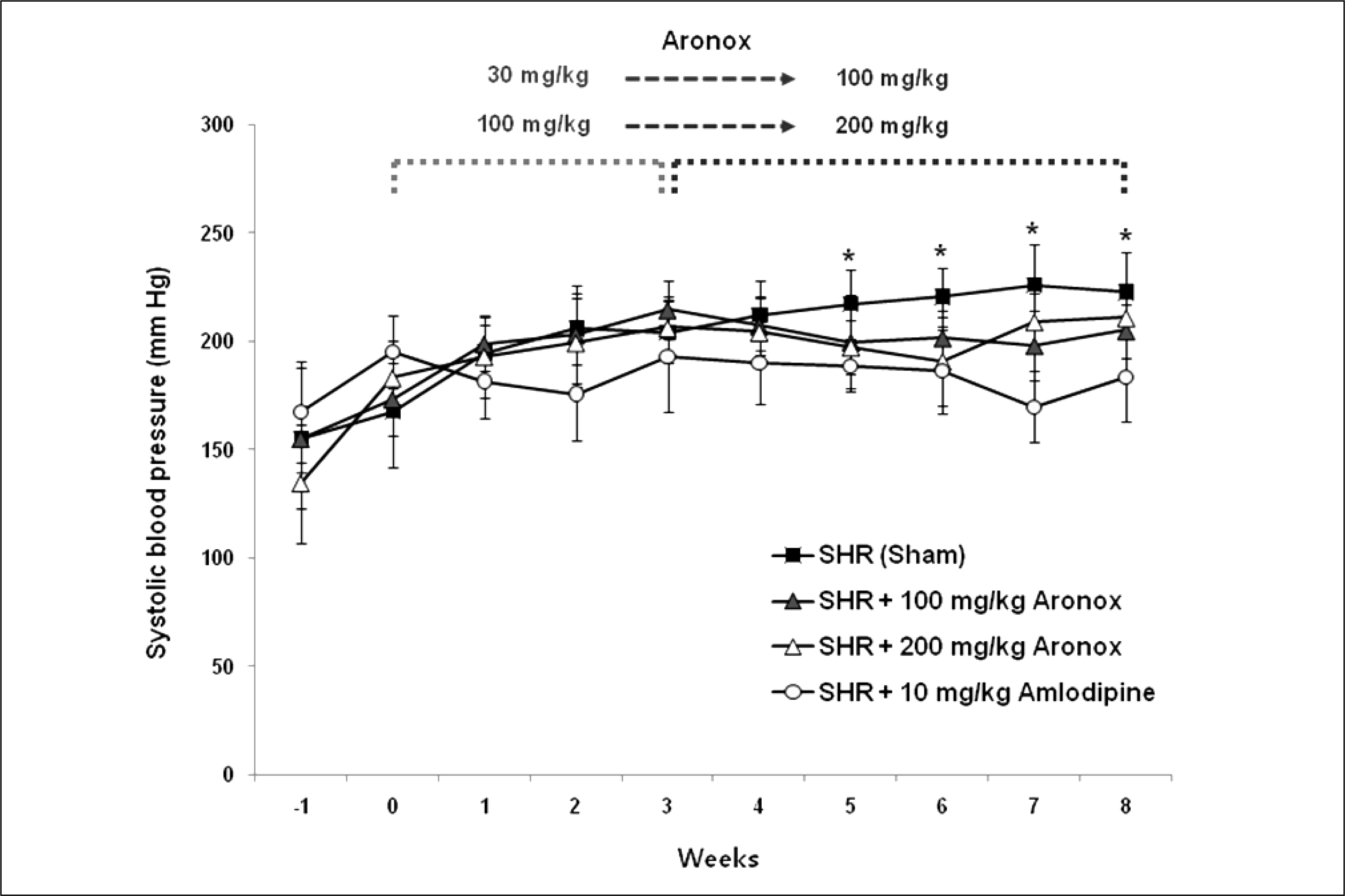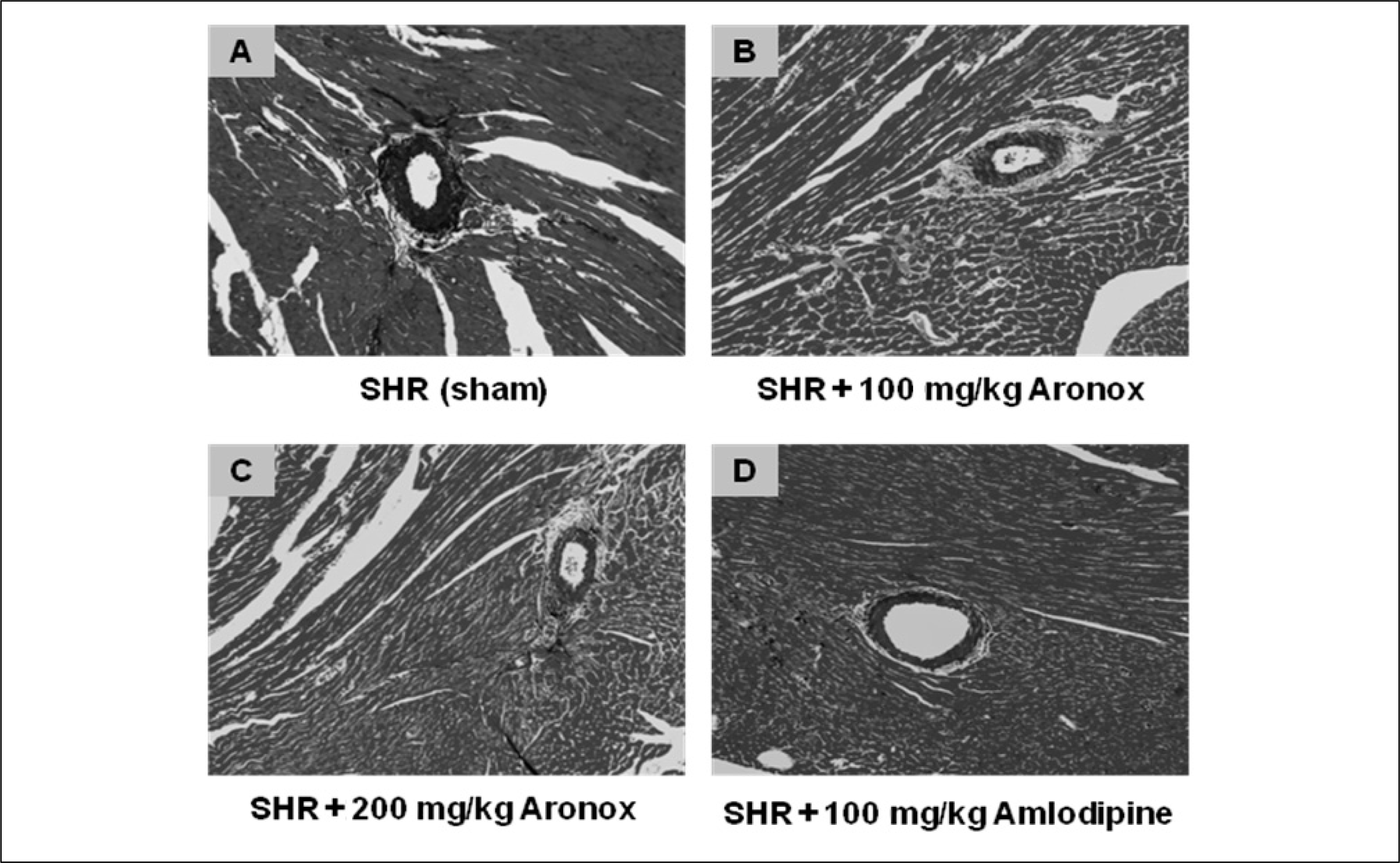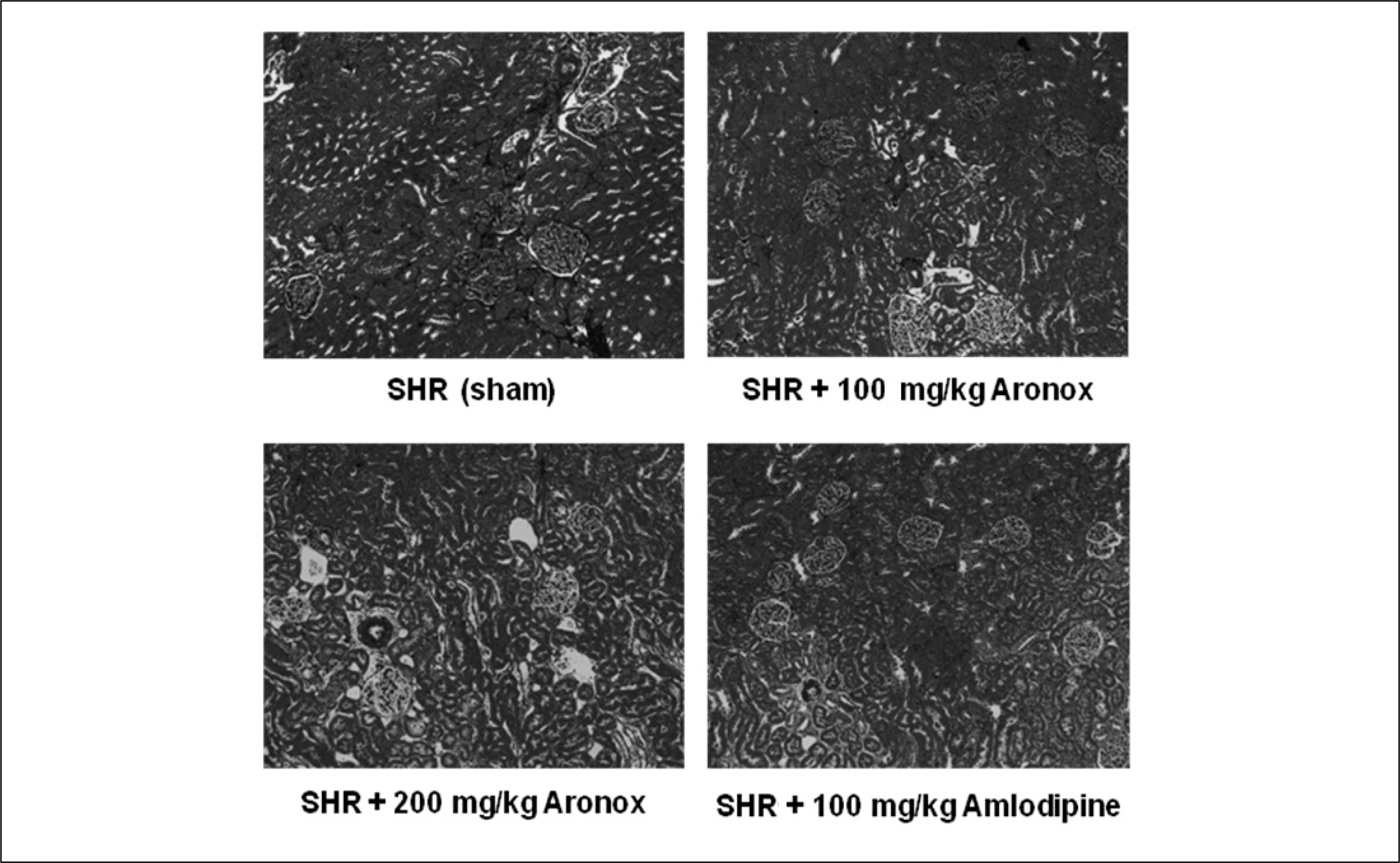ABSTRACT
Background:
Aronox is an anthocyanin-rich extract from Aronia melanocarpa E which is known to have anti-inflammatory effect in atherosclerosis due to high anti-oxidative activity. This study was conducted to evaluate the preventive and therapeutic effect of Aronox on hypertension and metabolic status in spontaneously hypertensive rats (SHR).
Methods:
Seven-week-old male SHR were orally administrated with Aronox (low dose; 100 mg/kg, n = 4 or high dose; 200 mg/kg, n = 3) or amlodipine (10 mg/kg, n = 7) and sham (n = 10) for 8 weeks. Aronox was administered 30 mg/kg for the first 3 weeks and then increased to 100 mg/kg (low dose group) or 100 mg/kg to 200 mg/kg (high dose group). Systolic blood pressure (SBP) was measured every week by tail cuff method. At 8 weeks, fasting lipid level was measured. Heart and kidney stained with Masson’s trichrome.
Results:
Aronox or amlodipine treatment showed significantly lower SBP compared with sham (202.2 ± 10.2 mm Hg in low dose group, 202.0 ± 12.6 mm Hg in high dose group and 187.4 ± 22.7 mm Hg in amlodipine group vs. 224.4 ± 12 mm Hg in sham-SHR, p < 0.005). There were no significant differences in cardiac and renal weight corrected by body weight among 3 groups. Aronox and amlodipine treatments significantly decreased fasting glucose and showed a trend of decrease in triglyceride level. Aronox or amlodipine treatment for 8 weeks showed less collagen deposition changes compared to sham.
Go to : 
References
1. Kulling SE, Rawel HM. Chokeberry (Aronia melanocarpa)-A review on the characteristic components and potential health effects. Planta Med. 2008; 74:1625–34.
2. Oszmianski J, Sapis JC. Anthocyanins in fruits of Aronia melanocarpa (Chokeberry). J Food Sci. 1988; 53:1241–2.

3. Naruszewicz M, Laniewska I, Millo B, Dluzniewski M. Combination therapy of statin with flavonoids rich extract from chokeberry fruits enhanced reduction in cardiovascular risk markers in patients after myocardial infraction (MI). Atherosclerosis. 2007; 194:e179–84.

4. Oszmianski J, Wojdylo A. Aronia melanocarpa phenolics and their antioxidant activity. Eur Food Res Technol. 2005; 221:809–13.

5. Niedworok J, Blaszczyk J, Kopff M. Antioxidant activity of anthocyanins from Aronia melanocarpa. Balnelogia Polska. 1993; 37:5–10.
6. Borissova P, Valcheva S, Belcheva A. Antiinflammatory effect of flavonoids in the natural juice from Aronia melanocarpa, rutin and rutin-magnesium complex on an experimental model of inflammation induced by histamine and serotonin. Acta Physiol Pharmacol Bulg. 1994; 20:25–30.
7. Bell DR, Gochenaur K. Direct vasoactive and vasoprotective properties of anthocyanin-rich extracts. J Appl Physiol. 2006; 100:1164–70.

8. Broncel M, Kozirog M, Duchnowicz P, Koter-Michalak M, Sikora J, Chojnowska-Jezierska J. Aronia melanocarpa extract reduces blood pressure, serum endothelin, lipid, and oxidative stress marker levels in patients with metabolic syndrome. Med Sci Monit. 2010; 16:CR28–34.
9. Cha MJ, Lee HY, Ahn SV, Han KR, Park JB, Lim SJ. et al. Prevalence and clinical characteristics of metabolic syndrome in Korean hypertensive patients Korean Hypertens J. 2009; 15:37–44.
10. Qin B, Anderson RA. Chokeberry extract consumption inhibits weight gain by modulating adipogenesis, insulin signaling, and inflammatory related gene expression in adipose tissue in rats fed a fructose rich diet. FASEB J. 2010; 24:555–7.

11. Valcheva-Kuzmanova S, Kuzmanov K, Mihova V, Krasnaliev I, Borisova P, Belcheva A. Antihyperlipidemic effect of Aronia melanocarpa fruit juice in rats fed a high-cholesterol diet. Plant Foods Hum Nutr. 2007; 62:19–24.

12. Sikora JM, Kostka B, Kozirog-Kolacinska M, Chojnowska-Jezierska J, Mikiciuk-Olasik E, Broncel M. The influence of anthocyanins from Aronia melanocarpa on platelet aggregation in patients with metabolic syndrome. Zjazd Polskiego Towarzystwa Biochemicznego, Sympozjum A [on-line journal]. 1998–2011. [cited 2011 Sep25]. Available from:. http://www.science24.com/paper/10824.
13. Broncel M, Kozirog-Kolacinska M, Andryskowski G, Duchnowicz P, Koter-Michalak M, Owczarczyk A, et al. Effect of anthocyanins from Aronia melanocarpa on blood pressure, concentration of endothelin-1 and lipids in patients with metabolic syndrome. Pol Merkur Lekarski. 2007; 23:116–9.
14. Valcheva-Kuzmanova S, Kuzmanov K, Tancheva S, Belcheva A. Hypoglycemic and hypolipidemic effects of Aronia melanocarpa fruit juice in streptozotocin-induced diabetic rats. Methods Find Exp Clin Pharmacol. 2007; 29:101–5.
15. Jurgonski A, Juskiewicz J, Zdunczyk Z. Ingestion of black chokeberry fruit extract leads to intestinal and systemic changes in a rat model of prediabetes and hyperlipidemia. Plant Foods Hum Nutr. 2008; 63:176–82.

16. Choi WH, Lee CB, Lee BH. The effect of obesity in non-insulin dependent diabetes mellitus on insulin level and blood pressure. Korean Hypertens J. 1998; 4:112–20.
17. Valcheva-Kuzmanova S, Borisova P, Galunska B, Krasnaliev I, Belcheva A. Hepatoprotective effect of the natural fruit juice from Aronia melanocarpa on carbon tetrachloride-induced acute liver damage in rats. Exp Toxicol Pathol. 2004; 56:195–201.

18. Valcheva-Kuzmanova SV, Popova PB, Galunska BT, Belcheva A. Protective effect of Aronia melanocarpa fruit juice pretreatment in a model of carbon tetrachloride -induced hepatotoxicity in rats. Folia Med (Plovdiv). 2006; 48:57–62.
19. Gasiorowski K, Brokos B. DNA repair of hydrogen peroxide-induced damage in human lymphocytes in the presence of four antimutagens. A study with alkaline single cell gel electrophoresis (comet assay). Cell Mol Biol Lett. 2001; 6:897–911.
20. Gasiorowski K, Szyba K, Brokos B, Kolaczynska B, Jankowiak-Wlodarczyk M, Oszmianski J. Antimutagenic activity of anthocyanins isolated from Aronia melanocarpa fruits. Cancer Lett. 1997; 119:37–46.
Go to : 
 | Fig. 1.
The flow chart of systolic blood pressure (SBP) changes during treatment of aronox or amlodpine. From the point of 5 week treatment, the treatment groups with aronox or amlodipine showed significant lower SBP compared with sham group. *p < 0.05 for sham vs. aronox 100 mg/kg, 200 mg/kg and amlodipine. SHRs, spontaneously hypertensive rats. |
 | Fig. 2.
Microscopic findings of effects of aronox or amlodpine on cardiac fibrosis. Masson’s trichrome staining of left ventricle for collagen (blue) detection showed more fibrotic changes around perivascular region in sham group (A) compared with aronox or amlodipine treatment group (B-D) (100×). SHRs, spontaneously hypertensive rats. |
 | Fig. 3.
Microscopic findings of effects of aronox or amlodpine on renal fibrosis. Masson’s trichrome staining of kidney for collagen (blue) detection showed more fibrotic changes around perivascular (100×) region in sham group (A) compared witharonox or amlodipine treatment group (B-D) (100×). SHRs, spontaneously hypertensive rats. |
Table 1.
Body weight (BW), heart & left ventricle wet weights normalized by BW and kidney wet weights normalized by BW in aronox-administrated SHR
Table 2.
The serum level of total protein, blood urea nitrogen, creatinine, cholesterol, glucose and triglyceride in aronox-administrated SHR




 PDF
PDF ePub
ePub Citation
Citation Print
Print


 XML Download
XML Download